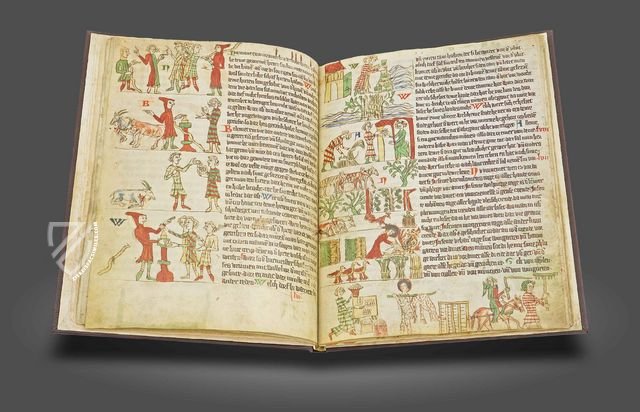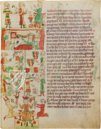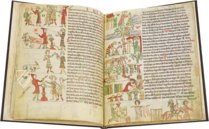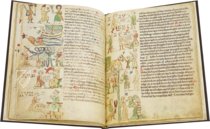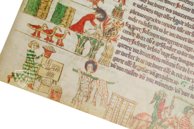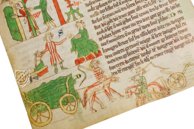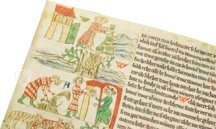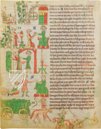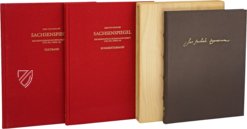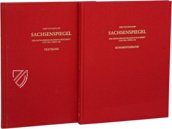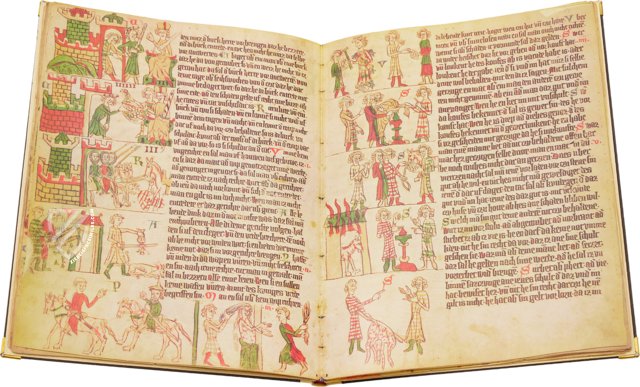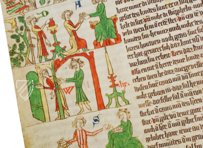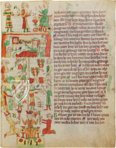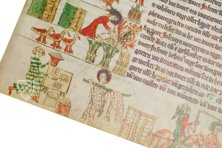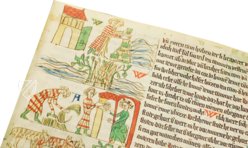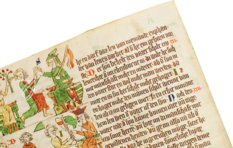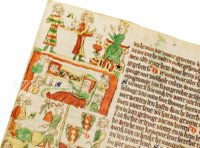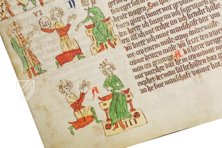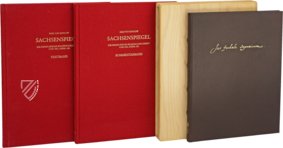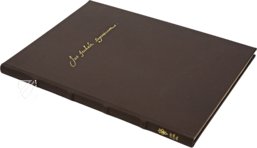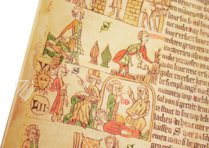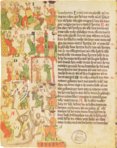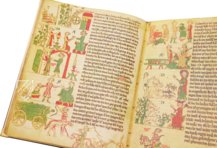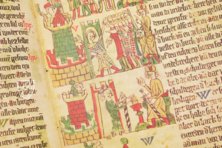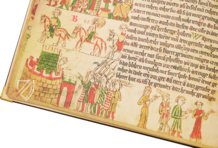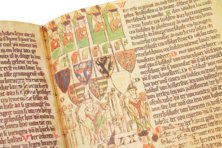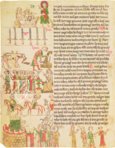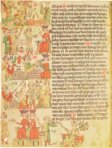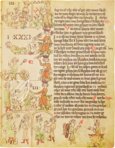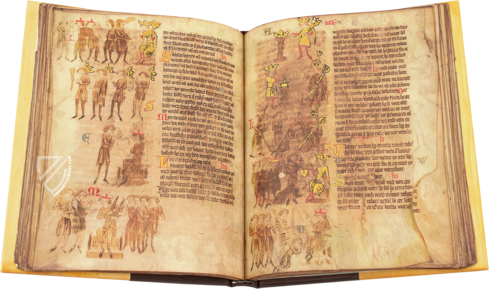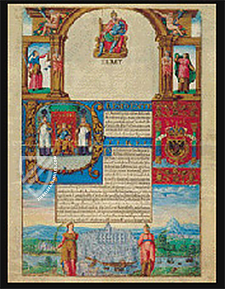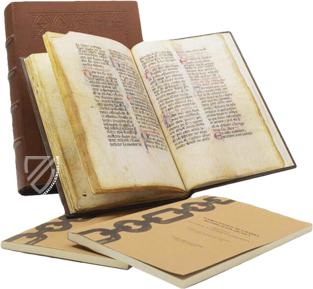Heidelberg Mirror of Saxony
(1,000€ - 3,000€)
One of oldest and most important German law books has also had one of the most turbulent histories of any medieval manuscript. The Heidelberg Mirror of Saxony is the only copy of a now lost 13th century original by Eike von Repgow. After a mysterious first few centuries of ownership, the manuscript first made its way from a member of the Fugger family in Augsburg to Heidelberg, where it became part of the famous Biblioteca Palatina before it was pillaged along with the rest of the library during the Thirty Year's War, and was finally returned to Heidelberg in the 19th century. Today, it comprises one of the greatest treasures of the Heidelberg University Library and one of the earliest sources on medieval German law ranging from common law to feudal rights.
Heidelberg Mirror of Saxony
No other book has shaped the history of German law in such a way as the Mirror of Saxony. After centuries of following a solely verbal tradition of law, the Mirror of Saxony represents the first written recording of everyday life and of the approved legal customary laws which applied only to a certain geographical region (in this case Saxony). Eike von Repgow wrote and compiled this work between 1220 and 1235 in the language of his homeland in lower-Germany, thereby creating not only the most important and unequalled German book of law, but also the first work of prose in the German language. The title Mirror was chosen by the author according to medieval speculum literature. Like a mirror, this textbook represented a reflection of the Christian world order and in the same manner Eike's Mirror also provided the Saxons with a view of "justice and injustice".
The Mirror of Saxony - Contents
The prologue contains an incantation by the author of the divine origin of justice and calls upon all people not to be lead astray from the law. The following common law regulates all questions about laws concerning village and neighbor, family and inheritance rights, constitutional law; including criminal, constitutional, and procedural law. The second main part of this book summarizes the norms of feudal rights, which covers the relationship between the feudal lords and their vassals. Thereby the Mirror of Saxony provides binding guidelines for all legal questions concerning cohabitation of peoples from different social groups.
The Earliest Mirror of Saxony Manuscript
The Heidelberg Mirror of Saxony manuscript is not dated, however, based on the form of the text, the image script, and especially the coat of arms originating from the northeastern region of Harz, its date of origin can be placed between 1295 and 1304. Originally the manuscript probably consisted of 92 pages, from which only a third now remain. The entire first book of common law is missing as well as parts of the second and third book and parts concerning feudal rights. These sides were probably excluded because they were so damaged, as can be seen in the condition of Image 19v and 20v. The state of preservation of the text and images differs and it is evident that these damages caused by pollution, abrasions, and fingermarks all indicate the frequent and heavy use of the Heidelberg Mirror of Saxony.
The Text: A Close Relationship to Eike von Repgows’ Original Version
Due to its similarity to the original text by Eike von Repgow, this Mirror is afforded a special importance. Upon its emergence at the turn of the 14th century, it shared a close temporal as well as spatial bond to the lost original manuscript, whose own emergence is likewise assumed to be only a few decades earlier in the region of Harz. The style of the illustrations provides a connecting link and indicates that most likely they were directly derived from the original.
Text and Images – a One-Time Collective Composition
The Heidelberg manuscript is characterized by a great harmony between text and images. This allows certain conclusions to be drawn about the illustrator, who possessed the ability to capture the quintessence of the legal text and interpret it in his own way, by exposing particular figurative aspects. In the rows of images running side by side the text, the written law is translated into a sequence of images – the imagery scenes therefore emerge out of the text. Through the complexity of the text, different temporal levels are described. The content of law contained in this manuscript is portrayed through the people and their attire, hand gestures and body posture, and symbols and subject matter of everyday life in such a way that the figures themselves become animated through their lively expression. The anonymous illustrator not only uses traditional symbols and gestures but also creates new forms. His main medium of expression in the scenes of justice is gestures of the hand, explaining their over-enlarged depiction in his drawings. This feature is not so strongly apparent in later manuscripts. Likewise noticeable in the Heidelberg manuscript is the frequent drawing of figures with many arms, which was often and necessarily used in order to portray the somewhat complicated procedures of feudal law.
The Fugger, the Palatina, and Rome
Little is known about the whereabouts of the manuscript since its time of origin up until the second half of the 16th century. It appeared in accounts from Heidelberg for the first time towards the end of the 16th century. At this time in Heidelberg, a book collection which became internationally known as the “Bibliotheca Palatina”, emerged out of the creation of a university in 1386 and the passion for books of the prince-electors' court. The Augsburg patrician Ulrich Fugger, who came from a branch of the well-known mercantile and banker family, had the controlling interest in this book collection's brilliant development. Due to his conversion to the Protestant faith and his considerable debts (caused not in least part to his generous book purchases and his lack of mercantile interest), Ulrich found himself completely at odds with his family. He found his refuge in Heidelberg with Prince Friedrich III. from Pfalz. In 1567 his library was brought from Augsburg to Heidelberg and upon his death in 1584, in accordance with his will, it finally became an integral part of the Biblioteca Palatina. One citation from the Fugger Library in 1571 calls it: „ein alt tuff Perment geschrieben buchlin von Lehenrechten und andern, mit altfranckischen figuren.“
In the Confusion of War
During the Thirty Years' War, Johann t’Serclaes von Tilly captured Heidelberg and in so doing, the Bibliotheca Palatina, along with our codex, was presented by Duke Maximillian of Bavaria to Pope Gregory XV and thus brought to Rome in 1623 by the Roman emissary Leo Alacci. The Mirror of Saxony was probably protected up until this time by only a simple wooden-cover binding which, due to weight considerations was later replaced by a lighter flexible parchment binding. The manuscript remained a part of the Vatican library in Rome until the Pope gave it back to the Bibliotheca Palatina in Heidelberg along with other German manuscripts in 1816. Since this time the codex is in safekeeping at the Heidelberg University Library.
Codicology
- Alternative Titles
- Der Heidelberger Sachsenspiegel
- Size / Format
- 60 pages / 30.0 × 23.5 cm
- Origin
- Germany
- Date
- Beginning of the 14th century
- Epochs
- Style
- Language
- Illustrations
- 337 miniatures featured alongside their relevant texts
- Content
- Common law and feudal rights in medieval Germany
- Previous Owners
- Ulrich Fugger (1474–1584)
Pope Gregory XV (1554–1623)
Heidelberg Mirror of Saxony
Feudal Law – Banner Fief
An enthroned king is shown at the bottom granting banner fiefs to two of his vassals, a bishop on the left and a secular lord on the right. Ecclesiastical banner fiefs were represented by scepters while secular lords were given an actual banner to represent their military responsibilities. These fiefdoms were indivisible and often a precursor for elevation to the ranks of the empire’s princes. The scenes above show the return of a fief (right) and the unlawful revocation of a fief (left).

Heidelberg Mirror of Saxony
Landrecht, Second Book, Statutes 56–58
Marginal décor illustrates the German legal texts on this page and are labelled with the initial from the relevant passage. For example, labelled “W” in the upper-left corner, two men create a dam to protect their village using blocks of turf and grass. Under “A”, a man is shown both harvesting grain and paying in coin instead of kind.
Bright shades color the cheery figures who smile as they carry out various tasks. Although this section deals with “land law”, it also features a hagiographic scene in the footer: St. Bartholomew is pictured with his own flayed skin hung over a pole he carries and stands before a figure seated at a table covered with coins. It is a playful metaphor for the pain of interest and lease payments.

#1 Der Heidelberger Sachsenspiegel
Language: German
The comprehensive scientific commentary (in German) was compiled by an expert team under the direction of publisher, Dr. Dietlinde Munzel-Everling (Wiesbaden) and Professor DDr. Gernot Kocher (Graz) and highlights the origin and history of the manuscript as well as the historical environment of the times. It allows the viewer an insight into many different aspects of medieval everyday life which are brought to life in a most impressive way right before the readers’ very eyes.
The text volume is a separate volume which accompanies the facsimile and helps to clarify images as well as text found in the original manuscript. The original lines of text from the manuscript are in old German and contain many abbreviations and an old system of punctuation. Therefore the text volume transcribes in German each individual line of text by explaining all abbreviations and converting the punctuation style into a modern-day system.
Running parallel to this on the opposite page is an explanation of the content and iconographic details of each individual scene found in the original manuscript.
(1,000€ - 3,000€)
#2 Der Heidelberger Sachsenspiegel
(1,000€ - 3,000€)
- Treatises / Secular Books
- Apocalypses / Beatus
- Astronomy / Astrology
- Bestiaries
- Bibles / Gospels
- Chronicles / History / Law
- Geography / Maps
- Saints' Lives
- Islam / Oriental
- Judaism / Hebrew
- Single Leaf Collections
- Leonardo da Vinci
- Literature / Poetry
- Liturgical Manuscripts
- Medicine / Botany / Alchemy
- Music
- Mythology / Prophecies
- Psalters
- Other Religious Books
- Games / Hunting
- Private Devotion Books
- Other Genres
- Afghanistan
- Armenia
- Austria
- Belgium
- Colombia
- Croatia
- Cyprus
- Czech Republic
- Denmark
- Egypt
- Ethiopia
- France
- Germany
- Greece
- Hungary
- India
- Iran
- Iraq
- Israel
- Italy
- Japan
- Lebanon
- Luxembourg
- Mexico
- Morocco
- Netherlands
- Palestine
- Peru
- Poland
- Portugal
- Russia
- Serbia
- Spain
- Sri Lanka
- Sweden
- Switzerland
- Syria
- Turkey
- Ukraine
- United Kingdom
- United States
- Uzbekistan
- Aboca Museum
- Ajuntament de Valencia
- Akademie Verlag
- Akademische Druck- u. Verlagsanstalt (ADEVA)
- Aldo Ausilio Editore - Bottega d’Erasmo
- Alecto Historical Editions
- Alkuin Verlag
- Almqvist & Wiksell
- Amilcare Pizzi
- Andreas & Andreas Verlagsbuchhandlung
- Archa 90
- Archiv Verlag
- Archivi Edizioni
- Arnold Verlag
- ARS
- Ars Magna
- ArtCodex
- AyN Ediciones
- Azimuth Editions
- Badenia Verlag
- Bärenreiter-Verlag
- Belser Verlag
- Belser Verlag / WK Wertkontor
- Benziger Verlag
- Bernardinum Wydawnictwo
- BiblioGemma
- Biblioteca Apostolica Vaticana (Vaticanstadt, Vaticanstadt)
- Bibliotheca Palatina Faksimile Verlag
- Bibliotheca Rara
- Boydell & Brewer
- Bramante Edizioni
- Bredius Genootschap
- Brepols Publishers
- British Library
- C. Weckesser
- Caixa Catalunya
- Canesi
- CAPSA, Ars Scriptoria
- Caratzas Brothers, Publishers
- Carus Verlag
- Casamassima Libri
- Chavane Verlag
- Christian Brandstätter Verlag
- Circulo Cientifico
- Club Bibliófilo Versol
- Club du Livre
- CM Editores
- Collegium Graphicum
- Collezione Apocrifa Da Vinci
- Comissão Nacional para as Comemorações dos Descobrimentos Portugueses
- Coron Verlag
- Corvina
- CTHS
- D. S. Brewer
- Damon
- De Agostini/UTET
- De Nederlandsche Boekhandel
- De Schutter
- Deuschle & Stemmle
- Deutscher Verlag für Kunstwissenschaft
- DIAMM
- Droz
- E. Schreiber Graphische Kunstanstalten
- Ediciones Boreal
- Ediciones Grial
- Ediclube
- Edições Inapa
- Edilan
- Editalia
- Edition Deuschle
- Edition Georg Popp
- Edition Leipzig
- Edition Libri Illustri
- Editiones Reales Sitios S. L.
- Éditions de l'Oiseau Lyre
- Editions Medicina Rara
- Editorial Casariego
- Editorial Mintzoa
- Editrice Antenore
- Editrice Velar
- Edizioni Edison
- Egeria, S.L.
- Eikon Editores
- Electa
- Emery Walker Limited
- Enciclopèdia Catalana
- Eos-Verlag
- Ephesus Publishing
- Ernst Battenberg
- Eugrammia Press
- Extraordinary Editions
- Fackelverlag
- Facsimila Art & Edition
- Facsimile Editions Ltd.
- Facsimilia Art & Edition Ebert KG
- Faksimile Verlag
- Feuermann Verlag
- Folger Shakespeare Library
- Franco Cosimo Panini Editore
- Friedrich Wittig Verlag
- Fundación Hullera Vasco-Leonesa
- G. Braziller
- Gabriele Mazzotta Editore
- Gebr. Mann Verlag
- Gesellschaft für graphische Industrie
- Getty Research Institute
- Giovanni Domenico de Rossi
- Giunti Editore
- Graffiti
- Grafica European Center of Fine Arts
- Guido Pressler
- Guillermo Blazquez
- Gustav Kiepenheuer
- H. N. Abrams
- Harrassowitz
- Helikon
- Hendrickson Publishers
- Henning Oppermann
- Herder Verlag
- Hes & De Graaf Publishers
- Hoepli
- Holbein-Verlag
- Hortus Deliciarum
- Houghton Library
- Hugo Schmidt Verlag
- Idion Verlag
- Il Bulino, edizioni d'arte
- ILte
- Imago
- Insel Verlag
- Instituto Nacional de Antropología e Historia
- Istituto dell'Enciclopedia Italiana - Treccani
- Istituto Ellenico di Studi Bizantini e Postbizantini
- Istituto Geografico De Agostini
- Istituto Poligrafico e Zecca dello Stato
- Italarte Art Establishments
- J. Thorbecke
- Jan Thorbecke Verlag
- Johnson Reprint Corporation
- Josef Stocker
- Josef Stocker-Schmid
- Jugoslavija
- Karl W. Hiersemann
- Kasper Straube
- Kaydeda Ediciones
- Kindler Verlag / Coron Verlag
- Kodansha International Ltd.
- Konrad Kölbl Verlag
- Kurt Wolff Verlag
- La Liberia dello Stato
- La Linea Editrice
- La Meta Editore
- Lambert Schneider
- Landeskreditbank Baden-Württemberg
- Leo S. Olschki
- Les Incunables
- Library of Congress
- Libreria Musicale Italiana
- Lichtdruck
- Lito Immagine Editore
- Lumen Artis
- Lund Humphries
- M. Moleiro Editor
- Maison des Sciences de l'homme et de la société de Poitiers
- Manuscriptum
- Martinus Nijhoff
- Maruzen-Yushodo Co. Ltd.
- MASA
- McGraw-Hill
- Militos
- Millennium Liber
- Müller & Schindler
- Nahar and Steimatzky
- National Library of Wales
- Neri Pozza
- Nova Charta
- Oceanum Verlag
- Odeon
- Orbis Mediaevalis
- Orbis Pictus
- Österreichische Staatsdruckerei
- Oxford University Press
- Pageant Books
- Parzellers Buchverlag
- Patrimonio Ediciones
- Pattloch Verlag
- PIAF
- Pieper Verlag
- Plon-Nourrit et cie
- Prestel Verlag
- Princeton University Press
- Prisma Verlag
- Priuli & Verlucca, editori
- Pro Sport Verlag
- Propyläen Verlag
- Pytheas Books
- Quaternio Verlag Luzern
- Reales Sitios
- Recht-Verlag
- Reichert Verlag
- Reichsdruckerei
- Riehn & Reusch
- Roberto Vattori Editore
- Rosenkilde and Bagger
- Roxburghe Club
- Salerno Editrice
- Sarajevo Svjetlost
- Schöck ArtPrint Kft.
- Scolar Press
- Scrinium
- Scripta Maneant
- Scriptorium
- Siloé, arte y bibliofilia
- SISMEL - Edizioni del Galluzzo
- Sociedad Mexicana de Antropología
- Société des Bibliophiles & Iconophiles de Belgique
- Soncin Publishing
- Sorli Ediciones
- Stainer and Bell
- Studer
- Styria Verlag
- Sumptibus Pragopress
- Szegedi Tudomànyegyetem
- Taberna Libraria
- Tarshish Books
- Taschen
- Tempus Libri
- Testimonio Compañía Editorial
- Thames and Hudson
- The Clear Vue Publishing Partnership Limited
- The Facsimile Codex
- The Folio Society
- The Marquess of Normanby
- The Richard III and Yorkist History Trust
- Tip.Le.Co
- TouchArt
- TREC Publishing House
- TRI Publishing Co.
- Trident Editore
- Typis Regiae Officinae Polygraphicae
- Union Verlag Berlin
- Universidad de Granada
- University of California Press
- University of Chicago Press
- Urs Graf
- Vallecchi
- Van Wijnen
- VCH, Acta Humaniora
- VDI Verlag
- VEB Deutscher Verlag für Musik
- Verlag Anton Pustet / Andreas Verlag
- Verlag Bibliophile Drucke Josef Stocker
- Verlag der Münchner Drucke
- Verlag für Regionalgeschichte
- Verlag Styria
- Vicent Garcia Editores
- W. Turnowsky
- Waanders Printers
- Wiener Mechitharisten-Congregation (Wien, Österreich)
- Wissenschaftliche Buchgesellschaft
- Wydawnictwo Dolnoslaskie
- Xuntanza Editorial
- Zakład Narodowy
- Zollikofer AG

